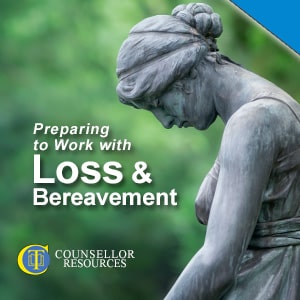Loss and Bereavement CPD for Counsellors
As a counsellor, you are likely to have clients who bring loss and bereavement to a session.
This article covers loss and bereavement CPD for counsellors looking to work with grief.
You will learn:
- The theory of loss and bereavement
- How attachment style effects loss
- Four tasks of mourning
- Different types of loss and grief
- Counselling clients who have experienced grief
- some myths about grief and loss

When thinking of doing loss and bereavement CPD, it is important to consider:
- your own experience of grief, ensuring that you have processed this (perhaps with the help of personal counselling) before trying to help clients to do so
- the sociological and religious context of loss and grief for the individual client
- the psychological and physical impacts of grief on the client.
There are various theories that can help us work effectively with loss and bereavement.
Watch this Lecture + Access Hundreds of Hours of CPD
Certified CPD for Qualified Counsellors
- Hundreds of hours of on-demand CPD lectures to help you stay current with your CPD ethical requirements
- Support, and be supported, by thousands of other counsellors as a member of the exclusive online community.
- Access your learning anytime you want ... anywhere you choose ... using any device type — desktop or mobile.

Grief and loss theory
Elisabeth Kubler-Ross developed the 5 stages of grief model, she was a Swiss-American psychiatrist and researcher in near-death studies.
Her five-stage theory (developed in the late 1960s) – which was originally designed to apply to people who were dying – is sometimes known as DABDA:
- Denial
- Anger
- Bargaining
- Depression
- Acceptance.
One of the major criticisms of this model is that it’s linear, whereas most people do not experience these emotions separately and in this order. By the mid-1970s, there was a general move away from this model.
Bowlby attachment and loss
In the 1970s, Colin Murray Parkes, a consultant psychiatrist at St. Christopher’s Hospice in London, joined forces with fellow psychiatrist John Bowlby (famous for attachment theory).
Together, they produced their own model of grief, which included:
- numbness (a sense of unreality and disbelief)
- yearning (severe feelings, including panic, crying, and physical pain)
- disorganisation and despair (depression, despair and apathy)
- and finally reorganisation (identity revised, ready to move on)
Worden's Four Tasks of Mourning
In 1990, William Worden (an American psychologist) developed the model of the four tasks of mourning.
He used the term ‘tasks’ to indicate that bereaved people do not follow stages but can move between the different tasks – and also to suggest that there is something that bereaved people can actively do to help themselves process their grief (rather than having to wait passively for the ‘stages’ to pass).
Worden’s tasks are:
- to accept the reality of the loss
- to work through the pain and the grief
- to adjust to the new environment
- to find an enduring connection with the deceased while moving forward with life
d. Stroebe and Schut: Dual-Process model of grief
Developed in the mid-1990s by these two Norwegian researchers, this model describes the two processes of grief:
- loss-orientated (in which people reflect, experiencing the emotions of grief)
- restoration-oriented (in which they distract themselves with tasks and look to the future more)
A person who is grieving healthily will oscillate between the two modes fairly equally, whereas someone who needs help might get ‘stuck’ in one mode or the other.
Types of loss and grief
There are various types of loss:
- Normal loss
- Anticipatory loss
- Complicated grief
- Secondary loss
- Traumatic loss
- Collective grief
Normal Grief
Most people grieve normally – without needing professional help (or needing only a small number of counselling sessions) to process this. There’s a gradual lessening of intense emotions, with individuals being able to re-engage with their daily lives.
They may still experience intense pain, guilt, anger etc. but ultimately they don’t get ‘stuck’ and they have the internal resources – and perhaps social support – to be able to move forward with their lives.
Anticipatory Grief
This occurs when a person knows they are going to lose someone or something before they actually do – this gives them time to prepare psychologically in a more gradual way.
It might occur when a client’s loved one has a terminal illness, or when their youngster is applying for university.
Anticipatory grief may also be felt in the lead-up to retirement or redundancy, or in divorce or separation.
Complicated Grief
This is a combination of traumatic and prolonged yearning for the deceased person.
There’s no one indicator for complicated grief, but it can present as a denial that the loved one has died.
Other signs include:
- numbness and detachment
- anger
- purposelessness
- mummification (a term coined by Geoffrey Gorer to describe the keeping of a dead person’s possessions for use when they return)
Complicated grief is very difficult to work with, with the person in limbo between the two parts of the dual-process model, unable to engage with either process. It can be so severe that people become psychotic.
Secondary Grief
When someone dies, there can be many practical losses alongside the primary (main emotional) one.
For example, a person who is bereaved of their partner may face financial difficulties, struggle to do tasks that used to belong to the person who died, or find they are not invited to social events due to no longer being part of a couple.
Other secondary losses include loss of role (e.g. as a carer), loss of support (if a team member dies) and loss of the future (as your plans are shattered).
The grief can focus on these types of losses rather than the loss of the actual person – and it may be necessary to deal with the secondary grief first.
Traumatic Grief
Traumatic grief is sudden and unexpected, and often results from horrific or frightening circumstances – e.g. natural disasters, terrorist attacks or suicide.
Another traumatic loss would be losing your child, given that this is out of the ‘natural order’.
In traumatic grief, you may need to work with the trauma first before it is possible to grieve.
Collective Grief
This can happen when someone very well-known and loved dies – for example, we saw this phenomenon in the UK on the death of Princess Diana.
Collective grief can trigger any unresolved grief, so that we are grieving for past losses of our own through the medium of the current collective loss.
Free Handout Download
Loss and Bereavement
Attachment and Grief Theory
Part of fully understanding this loss and bereavement CPD for counsellors and psychotherapists, is to look to attachment theory.
How much we invest emotionally in another person is directly correlated with how much grief we experience if we lose them.
This relates to John Bowlby’s attachment theory, which describes a cause-and-effect relationship between early attachment patterns and later reactions to loss.
When someone has an attachment disorder, they may have a significant problem in connecting with or separating from others.
Thus, complicated grief can be viewed as an attachment disorder – and may need a different intervention from counselling – e.g. the involvement of a psychologist and/or doctor, perhaps providing a more directive approach or even medication.
How much we invest emotionally in another person is directly correlated with how much grief we experience if we lose them.
In particular, a person who has an anxious attachment style is more likely to become heavily dependent on another person, which may lead to complicated grief if the loved one dies. There is also a risk that they might become over-dependent on their counsellor, transferring their dependence to us.
Another style of attachment – avoidant attachment (which makes a person compulsively self-reliant) – may lead to delayed grief, and fail to process the loss until much later down the line, perhaps when this is triggered by another event.
Other attachment-related risk factors for complicated grief include:
- weak parental bonding
- damaged sense of security due to childhood abuse or severe neglect
- childhood separation anxiety
- aversion to change (often a difficulty for people with autism or Asperger’s)
- feeling of being unsupported in grief
- lack of preparation for the death
- loss through suicide
Working with Complicated Grief
- First, ask yourself whether your level of training matches the client’s presentation. If not, making a referral is the ethical response.
- If the client has lost touch with reality, be gentle but also consider referral to their GP.
- Be vigilant for post-traumatic stress disorder (PTSD) and – if it may be present – make sure you know how to work safely with trauma.
- Read up on complicated grief therapy.
- If secondary grief is present, then consider signposting the client to other agencies that could help with any practical difficulties.
- If secondary loss is their main concern, don’t direct them to look at the primary loss; instead, let them get there at their own pace.
Somatic Symptoms
It’s not unusual for a bereaved person to have sudden and unexpected pain after the loss of a loved one, often reflecting the illness that the person had.
For example, a client who gets headaches might tell you that their partner died of a brain tumour.
Of course, it’s always sensible to get any new physical symptoms checked out by a doctor.
Myths about Grief
There are many myths about grief, including the following:
- The pain of loss will go faster if you ignore it.
- It’s important to be ‘strong’ in the face of loss.
- If you don’t cry, it means you aren’t sad about the loss.
- Grief should last about a year.
I trust you received value from doing this loss and bereavement online CPD for counsellors.
Free Handout Download
Loss and Bereavement